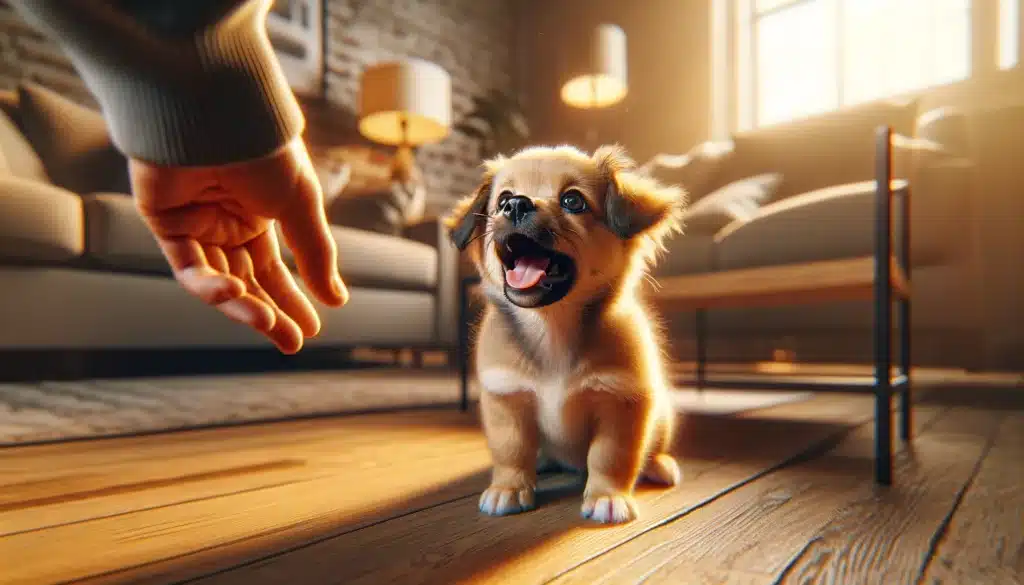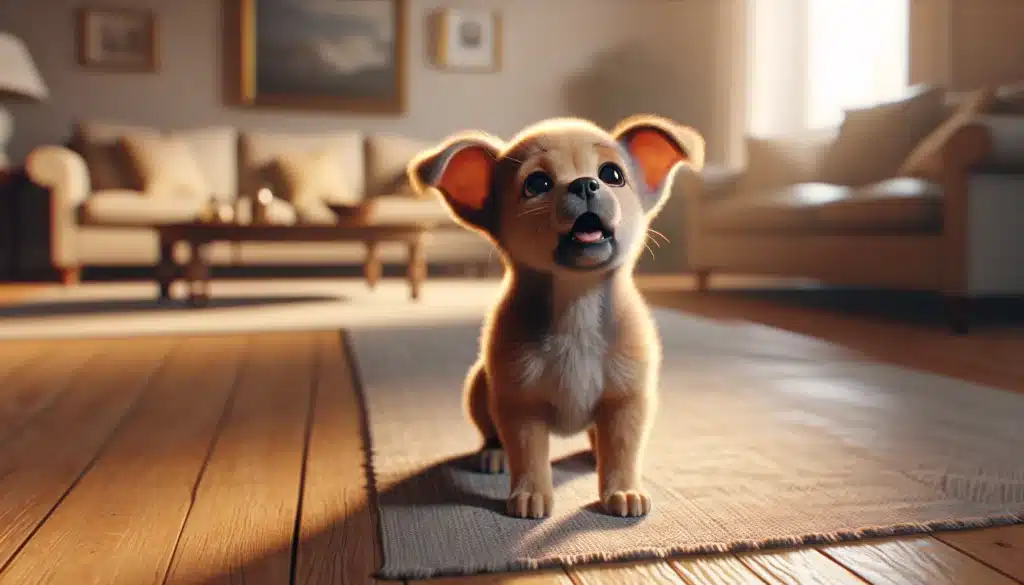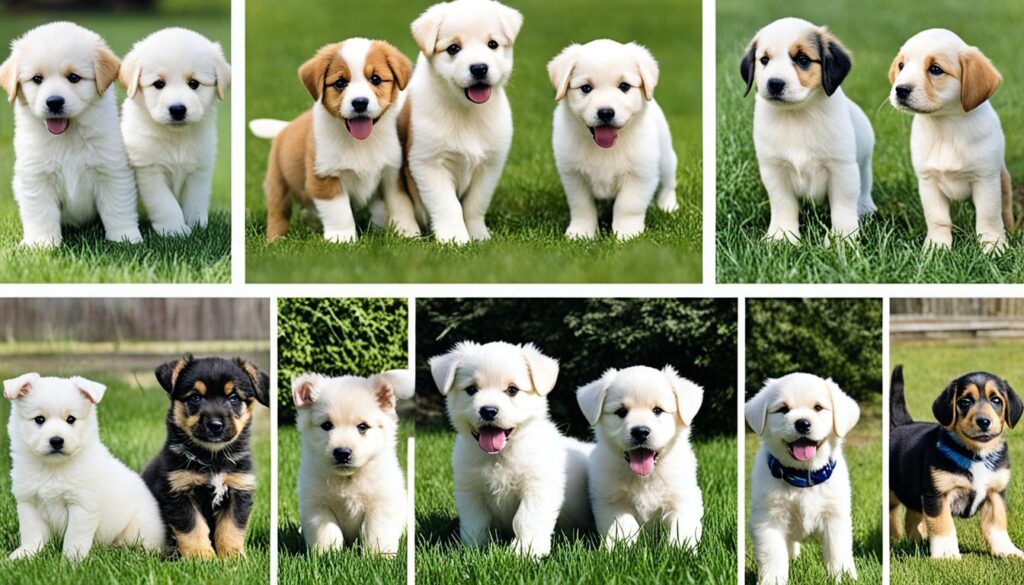One aspect of puppy development that many new owners encounter is puppy whining. While initially, it might appear like nothing more than an adorable way to get your attention, understanding the reasons behind your puppy’s whines can be crucial.
Like human babies, puppies are still figuring out the world around them. They use various communication methods, including whining, as they experience new emotions and situations. Being patient and observant of your pup’s behavior is essential to understanding their needs and supporting their development.
While it’s normal for puppies to whine from time to time, persistent whining might suggest an underlying issue. Addressing the root cause of your puppy’s whining can help you ensure their needs are met, promoting their overall well-being. Additionally, attending to whining promptly can prevent negative behavioral patterns from developing.

Key Takeaways
- Puppy whining is a standard form of communication, especially in the early stages of development.
- Understanding the reasons behind your puppy’s whining – attention-seeking, anxiety, discomfort, or basic needs – is crucial for providing appropriate care.
- Pay close attention to the type of whine, your puppy’s body language, and the situation to decipher the message they’re trying to convey.
- Addressing whining successfully involves providing comfort, establishing routines, and using positive reinforcement strategies to encourage calm behavior.
- Sometimes, persistent or excessive whining might indicate an underlying health issue, so consulting your veterinarian is essential.
What is Puppy Whining?
Puppy whining is a vocalization that takes the form of a high-pitched cry or whimper. Like a baby’s cry, whining is a fundamental form of communication for young pups. They complain to get attention, express emotions, or signal a need.
Puppy Whining: Understanding the Reasons Behind It
Puppies, those adorable bundles of fur and curiosity, have their unique ways of communicating with us. One of these methods is whining. While it can be endearing, prolonged, or excessive, whining can become quite bothersome. Let’s delve into why puppies whine and how to address this behavior.
Basic Needs and Desires:
- Hunger and Thirst: Puppies whine when they need food or water. Ensuring regular meals and hydration can alleviate this.
- Bathroom Breaks: Whining may signal that your puppy needs to relieve themselves. Promptly take them outside for potty breaks.
- Attention: Sometimes, puppies whine simply because they want your attention. Engage in playtime, cuddles, or interaction to meet their social needs.
- Comfort and Security: Puppies may whine if they’re cold, scared, or seeking comfort. Provide a warm, safe environment and soothing companionship.
Boredom and Loneliness:
- Puppies, like children, get bored. Lack of mental stimulation can lead to whining. Regular play, toys, and activities help keep them engaged.
- Loneliness can trigger whining. Ensure your puppy has companionship from you, other pets, or toys.
Anxiety and Stress:
- Whining can be a sign of anxiety or stress. If your puppy paces, trembles, or pants while whining, they may be fearful or restless.
- New environments, unfamiliar people, or separation from their family can cause anxiety. Gradual exposure and positive reinforcement can help.
Physical Discomfort or Pain:
- Puppies may whine due to physical discomfort. Joint pain, teething, or digestive issues can lead to whining.
- Observe if your puppy whines during specific activities (e.g., climbing stairs) and consult a vet if needed.
Attention-Seeking Behavior:
- Sometimes, puppies whine to get your attention. Similar to kids at the dinner table, they want interaction.
- Ensure you provide enough playtime, exercise, and mental stimulation to prevent boredom-related whining.
Separation Anxiety:
- Whining before you leave the house could indicate separation anxiety. Puppies with this condition may engage in destructive behaviors.
- Desensitization techniques and calming tools can help manage separation anxiety.
Understanding your puppy’s whining requires patience and observation. Address their needs promptly and seek professional advice if the behavior persists.

How to Interpret Your Puppy’s Whines
While whining might seem simple, there’s often more to it. To understand the message behind your puppy’s whines, it’s helpful to pay attention to the following:
Differentiating types of whines:
Notice the pitch, volume, and duration. Is it a short, playful whimper or a long, insistent cry? A high-pitched whine might indicate excitement, while a lower-pitched whimper could suggest fear or discomfort.
Observing body language:
Your puppy’s body language can provide valuable clues:
- Cowering or trembling might suggest fear or anxiety.
- Pacing or restlessness can indicate the need to eliminate or a sign of discomfort.
- Excited tail wagging and playful posture might mean your pup craves attention.
Context Matters:
Consider the situation in which the whining occurs. Did the whining start after you left the room? Perhaps it’s separation anxiety. Does it happen before mealtime? Your pup is likely expressing hunger.
By paying attention to these nuances and the context of the whining, you’ll be able to decipher your puppy’s messages better. This will allow you to address their needs effectively, promoting their well-being.
Addressing Puppy Whining
While some level of whining is expected with puppies, consistent and proactive efforts can help minimize excessive whining and promote positive behaviors. Here’s a deeper look at strategies to help your furry friend:
Providing comfort and security:
Puppies, especially young ones, must feel safe and secure. Offer a comfortable crate or bed as a designated safe space. Please place it in a familiar area where they can still see you or other family members. Keeping the crate near your bed at night can provide reassurance during those first few weeks. A familiar blanket or a piece of clothing with your scent can add comfort.
Establishing a routine:
Puppies thrive on predictability. A consistent routine for feeding, potty breaks, playtime, and naps can help reduce anxiety and minimize anticipatory whining. Stick to the schedule as closely as possible. Take your puppy out frequently for potty breaks, even if they don’t want to go out. This will help prevent accidents and teach them that eliminating outside gets rewarded.
Training tips to reduce whining:
- Ignore attention-seeking whining: While it might be tempting to respond to every whimper, doing so can inadvertently reinforce the behavior. If you’re confident your puppy’s basic needs are met (they’ve had water, food, a potty break, and aren’t injured), sometimes ignoring the whining is the right approach. They’ll learn that calm behavior gets rewarded with your attention.
- Reward desired behavior: Positively reinforce quiet and calm behavior by giving your pup treats, praise, gentle petting, or a favorite toy when they’re not whining. This helps them understand that being calm and quiet is what you expect and will earn them positive attention.
- Distraction techniques: If the whining persists, try distracting your puppy with a simple command like “sit” or “stay.” Reward them when they comply. You can also give them a puzzle toy or a chew to focus their attention elsewhere.
- Crate training: If done correctly, crate training can be valuable in managing whining. The crate becomes a haven where your puppy can relax and feel secure, minimizing anxiety-related whining. Start with short periods in the crate with plenty of positive reinforcement, gradually increasing the time as they become more comfortable.
Addressing separation anxiety:
If whining occurs when you leave their sight, work on managing it. Start by going them alone for very short periods and gradually increase your time away. Make your departures and returns low-key to minimize excitement. Leave them with a special toy or a treat-filled puzzle to provide a positive distraction.
Exercise and mental stimulation:
A tired puppy is less likely to whine out of boredom. Provide regular age-appropriate exercise and mental stimulation with walks, playtime, and safe chew toys.
Never punish your puppy for whining. Punishment creates fear and can lead to increased anxiety, hindering progress. Focus on patience, positive reinforcement, and managing the situations that lead to whining.
When to Seek Further Help: If the whining strategies aren’t helping, or your puppy’s whining seems excessive, consider consulting a certified dog trainer or behaviorist. They can offer personalized advice, help identify the root cause of the whining, and develop a tailored behavior modification plan.

When to Consult a Veterinarian
While most causes of puppy whining are behavioral or related to basic needs, it’s essential to take persistent whining seriously. In some cases, it could signal an underlying medical issue.
Identifying signs of health issues
Seek veterinary advice if you observe any of the following alongside your puppy’s whining:
- Changes in appetite: Loss of appetite or refusing food can indicate illness.
- Lethargy: If your typically energetic puppy seems unusually tired or listless, it warrants a checkup.
- Vomiting or diarrhea: These symptoms might indicate a gastrointestinal problem or a more severe condition.
- Changes in behavior: Sudden aggression, hiding, or significant personality changes suggest an underlying health concern.
- Excessive panting or difficulty breathing can be signs of respiratory or heart problems.
Trust your instincts: If your puppy’s whining seems excessive, or you feel something’s not quite right, don’t hesitate to consult your veterinarian. They can conduct a thorough examination to rule out any medical causes and give you appropriate guidance.
Conclusion
Puppy whining is a normal part of a young dog’s development. Understanding why your puppy whines is the first step to helping them communicate their needs effectively. By patiently observing their behavior, providing reassurance, and establishing a consistent routine, you can help your puppy feel secure and minimize excessive whining.
Every puppy is an individual. Some might whine more than others. If you have concerns about your puppy’s whining or if other worrying symptoms accompany it, don’t hesitate to consult your veterinarian. With patience, understanding, and appropriate guidance, you’ll help your furry companion transition into a happy, well-adjusted matured dog.
FAQs
Q: Is it normal for puppies to whine a lot?
A: It’s normal for puppies to whine, especially in their early weeks, as they adjust to a new environment and learn to communicate. However, excessive and persistent whining without apparent cause could indicate an issue and warrant further attention.
Q: How do I make my puppy stop whining at night?
A: Ensure your puppy has had a potty break immediately before bedtime. Create a cozy and safe sleeping space for them, such as a crate near your bed. You can comfort them with soft toys and a ticking clock to mimic a mother’s heartbeat. If the whining persists, brief potty breaks might be necessary, but avoid playing or giving extra attention.
Q: Should I ignore my puppy whining?
A: Sometimes, yes. If you’re sure all their basic needs are met (food, water, potty break) and they’re safe, ignoring attention-seeking whining can be adequate. However, don’t ignore whining that might indicate pain, anxiety, or a pressing need to go outside.
Q: Will my puppy grow out of whining?
A: Many puppies naturally whine less as they age, learn to communicate more effectively and feel more secure. However, consistent training and addressing the root causes of whining are crucial to minimizing this behavior and promoting a well-adjusted grown up dog.
Q: Why does my puppy whine when I leave the room?
A: Puppies may whine when you leave them alone because of separation anxiety. You can help reduce this anxiety by gradually increasing your time away from them, starting with short absences and providing a safe space with comforting toys and treats.

